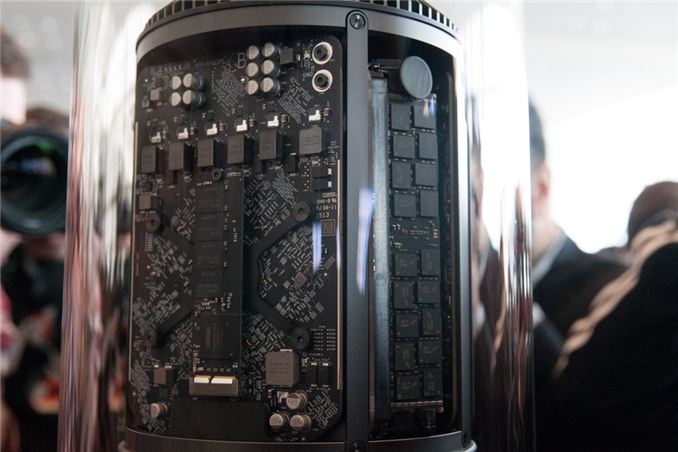Up Close with the New Mac Pro
by Anand Lal Shimpi on June 10, 2013 3:15 PM EST
In its keynote this morning, Apple teased its next-generation Mac Pro, due out later this year. Based on Ivy Bridge E, the new system will ship with two AMD FirePro GPUs with up to 4096 SPs and capable of delivering 7 TFLOPS of peak FP performance.
We got a close look at the chassis, which is 1/8 the size of the current Mac Pro. You lose any hope for internal expansion, but Apple outfitted the machine with three Falcon Ridge Thunderbolt 2 controllers to enable expansion via external storage and external Thunderbolt 2 expansion chassis options. Apple won't make any of its own Thunderbolt 2 expansion chassis, but you can expect that others will fill that void. With 20Gbps up/down on Thunderbolt 2, you should have enough bandwidth for any PCIe expansion.
Internally there are four DDR3 memory slots, as well as what looks like a proprietary PCIe SSD connector (I don't think it's M.2 unfortunately). Both GPUs are technically removable, but at least one is mounted as the same card as the PCIe SSD. Apple is putting every single PCIe lane available to use on the new Mac Pro.
















137 Comments
View All Comments
Zeratul56 - Monday, June 10, 2013 - link
At long last apple isn't robbing people blind by selling the extremely dated Mac Pro. As a system builder, I am not to fond of the new design though. It certainly is very apple in that once is built you can't really change anything about it internally.xinthius - Monday, June 10, 2013 - link
The RAM and SSD, along with the GPU modules are supposedly removable.This system is certainly not dated at all.
Zeratul56 - Monday, June 10, 2013 - link
i was referring to the old design, sorry for not being specific. It was extremely overpriced and filled with old hardware. The new design is by no means dated.Aegrum - Monday, June 10, 2013 - link
"With 20Gbps up/down on Thunderbolt 2, you should have enough bandwidth for any PCIe expansion."This statement is somewhat hyperbolic. That'd be equivalent to PCIe 3.0 x2.5 - a very far cry from what any current high-end dGPU would demand, let alone what the GPUs of the future demand. Even at 40Gbps, it's still a bottleneck on the card.
IMO, this is pretty awful news for pros. It's pretty and small, but will force you to buy a whole new system after a few gens of GPUs.
coder543 - Monday, June 10, 2013 - link
Let me remind you, until a year ago, all graphics cards were PCIe 2.0, and x16 at that. That means 8GB/s. That's Thunderbolt 1 spec. PCIe 3.0 as I understand it, gives 1GB/s per lane, so double PCIe 2.0. That means 16GB/s, which is within Thunderbolt 2 spec. What gives? And where are you getting the idea that each PCIe 3.0 lane is worth 8GB/s?coder543 - Monday, June 10, 2013 - link
PCIe 3.0 x16 is 16GB/s, just to clarify. This table confirms: http://www.hardwaresecrets.com/printpage/Everythin...You seem to be wildly mistaken about bandwidth needs, so this is actually really nice for the target customers. Not "awful news for pros" at all.
Dman23 - Monday, June 10, 2013 - link
This guy knows his stuff. It's amazing to me how uninformed people are on Thunderbolt and the power it brings by basically extending the PCI Express buss outside of the chassis of a computer. Its just as fast as if you plug a card into a PCI Express slot inside a computer. Hopefully, the Mac Pro when it comes out will eliminate this weird perception that somehow connecting a card using TB is slower then connecting via an express slot.Conficio - Tuesday, June 11, 2013 - link
Hmm, isn't the entire Thunderbold (1 or 2) running of 4xPCIe 2.0? That alone is the limitation.Conficio - Tuesday, June 11, 2013 - link
http://www.anandtech.com/show/7049/intel-thunderbo...Aegrum - Monday, June 10, 2013 - link
Where? How about - http://en.wikipedia.org/wiki/PCI_Express . PCIe 3.0 x16 is 8GBps (64Gbps). You're getting your bits and your bytes mixed up. 8 bits = 1 bite. Thunderbolt is 20GigaBITS per channel, AKA 2.5GBites.Yes, all the GPUs were PCIe 2.0 x16, which is PCIe 3.0 x8, almost four times faster than Thunderbolt 2. They showed in an article about the 7970 last year that PCIe 3.0 x2 would bottleneck a 7970: http://goo.gl/r2YW9 . What happens in 3 years when the GPUs require even *more* bandwidth? Tbolt 2.0 will be an even *larger* bottleneck.